Home Blog Business Executive Summary: A Guide to Writing and Presentation

Executive Summary: A Guide to Writing and Presentation
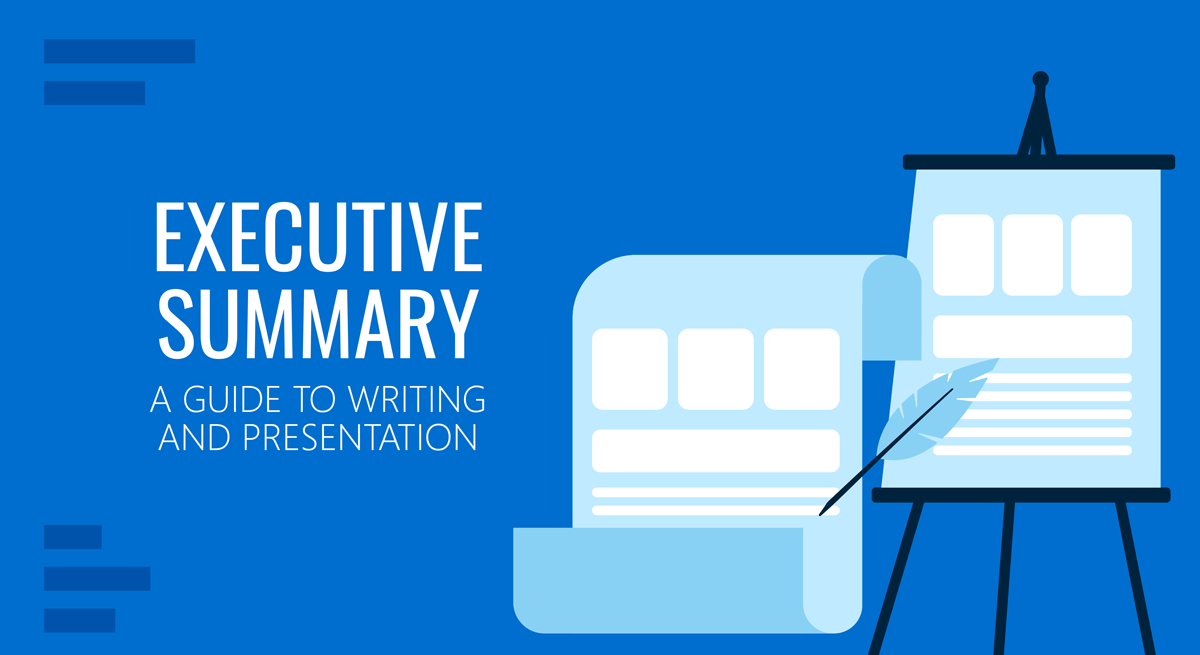
Executive summaries precede nearly every type of business document. Despite being the shortest part, they often leave the biggest impression on the reader. Yet, many writers choose to treat an executive summary as an afterthought. (And some presenters too!). Why? Because writing an executive summary is a seemingly hard task. But our mission is to prove otherwise!
What is an Executive Summary?
An executive summary is a preface to a larger business document such as an annual report, business plan, or whitepaper, succinctly summarizing the key discussion points. Effectively, an executive summary offers a preview of the content, so that the reader could form a baseline opinion about the contents prior to diving into a deep reading session.
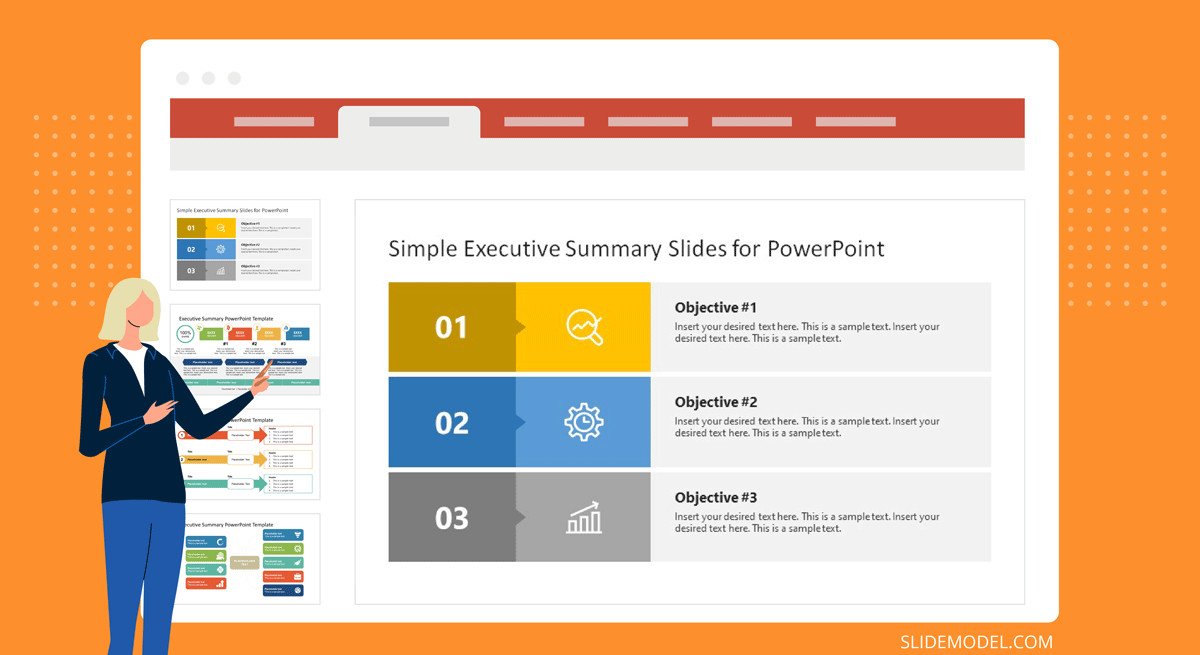
The University of Arizona offers a more elaborated executive summary definition which also notes that an executive summary should:
- Restate the purpose of the follow-up document
- Highlight the key discussion points and most notable facts
- Relay any notable results, conclusions, or recommendations
Though an executive summary is just a foreword to a bigger report, it’s one of the most labor-intensive items as you have to condense a lot of information into a high-level summary. Oftentimes, an executive summary also gets prominent placement in the follow-up presentation, done on the report.
Executive Summary Examples
Nearly every type of business document will have an executive summary. Some are better structured and presented than others. But it’s not just limited to business documents. Executive summaries are also used in scientific projects, articles, and education. Below are several admirable executive summary examples you may want to use as an inspiration for writing.
Accenture: Gaming: The Next Super Platform
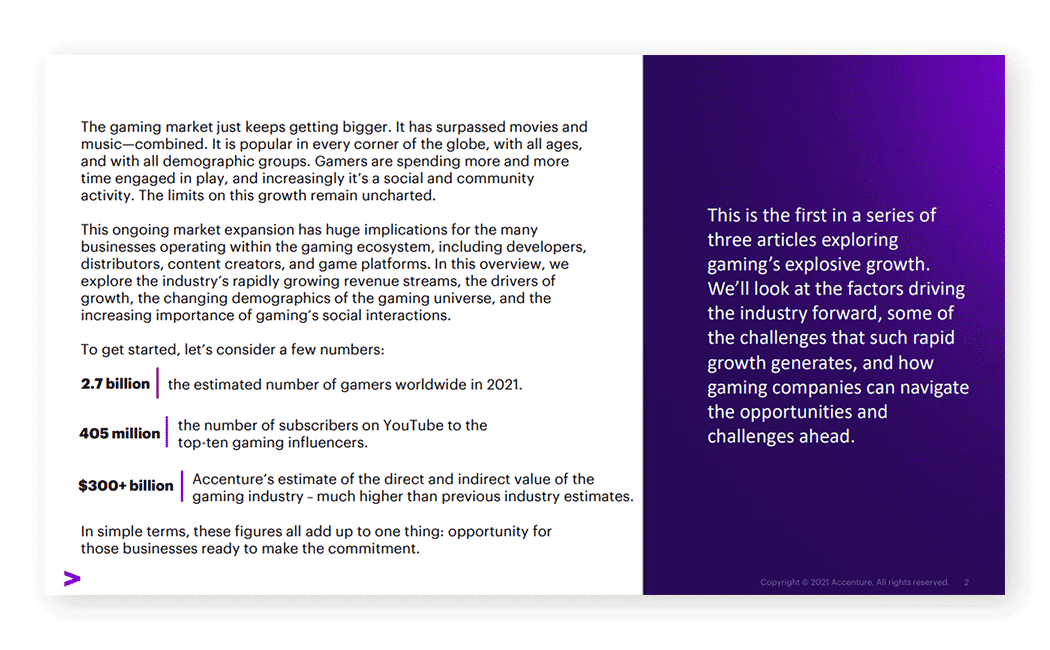
This executive summary for an industry report opens with some big quantifiable claims, clearly communicating the main agenda — describing the size and state of the global gaming market. The gaming industry is a huge market. The pullout texts on the sidebar further detail the scope of the document. Plus clarify for whom this report is intended.
IBM: Cost of a Data Breach Report 2020

IBM conducts an annual joint report on cybersecurity with Ponemon Institute. They open the executive summary with a brief recap of their mission and past research. Then dwell on this year’s findings and methodology. If you are writing an executive summary for a similarly massive original research, it’s worth focusing more on your techniques for obtaining data and arriving at the conclusions as IBM did.
Deloitte Digital: Exploring the value of emotion-driven engagement

Deloitte selected a more narrative style for this executive summary, mixing some key data points and methodology with the core messaging of the report. This is a good example of structured data presentation . On one hand, you have an engaging narration flow. On the other, the summary covers all the important discussion points.
Executive Summary Format
As the above executive summary examples illustrated, there is no one fit-it-all format for writing an executive study. The best approach depends on your report type, purpose, and contents.
That being said, an executive summary needs to fulfill several earlier mentioned criteria — offer a preview, provide key information at glance, showcase any results, recommendations. That’s what most readers expect to see on the first page after all.
The easiest way to approach writing is to draft a preliminary executive summary outline featuring the following subsections:
- General introduction, explaining the key problems discussed
- Main problem statement(s)
- Selected findings or recommendations
- The importance of discussed points
Since you’d also be likely working on presenting the executive summary to other stakeholders , it helps you keep the above structured as bullet points at first. So that you could easily transfer the main ideas to your executive summary PowerPoint slide .
How Long Should an Executive Summary Be?
As a rule of thumb, an executive summary should not go longer than one vertical page. That is an equivalent of 300-500 words, depending on the typeface. For longer reports, two pages (a horizontal split) may be acceptable. But remember, brevity is key. You are working on a trailer for a movie (the full report).
How to Write an Executive Summary: a 3-Step Framework
You can start with the aforementioned loose format and then adapt it to your document type. Remember, you don’t need to follow all the recommendations to a T. Instead, mix some ideas to make your executive summary sound both professional and engaging. Here are several tips for that:
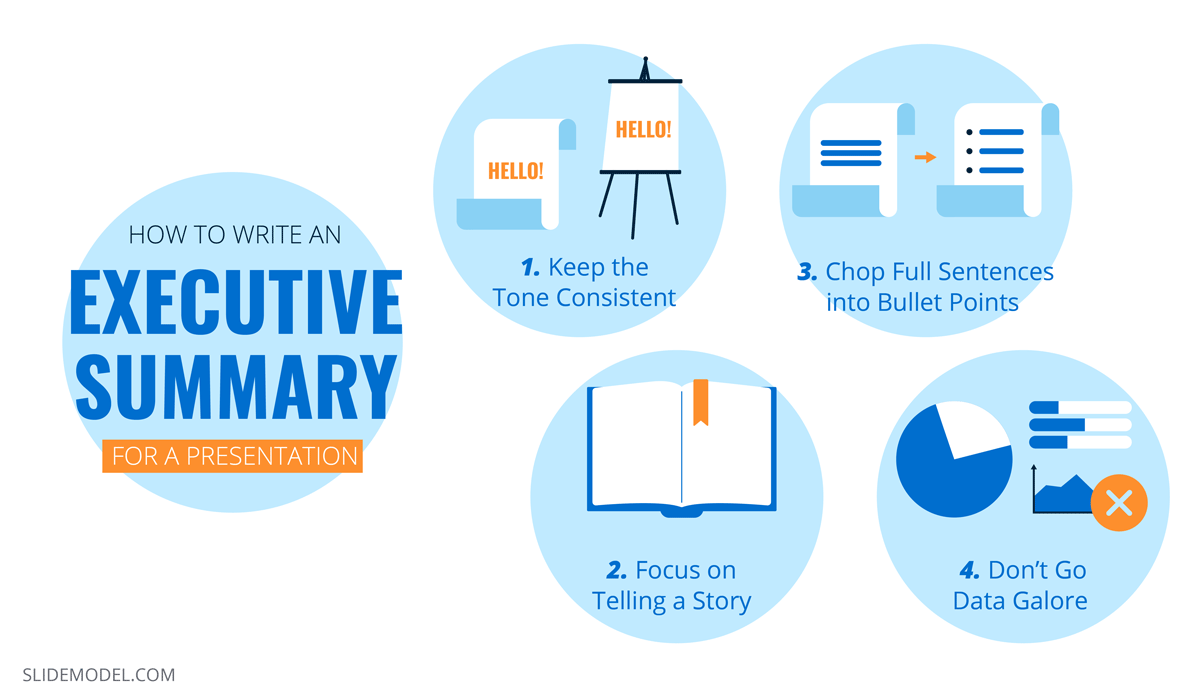
1. Start with a Problem Statement
Think of the first paragraph as if of an opening slide for a presentation : you need to make a big compelling statement that immediately communicates your agenda. Set the scene for the reader. There are several ways to do so:
- Answer the “why now” question in the opening paragraph
- Address the urgency of the matter
- Highlight the importance of the discussed issue
Alternatively, you can also go for a more traditional opening and explain the background of the research and discussed issue. For example, if you have conducted a go-to-market strategy evaluation for the team you can start by saying that “This report analyzed online furniture brand performance in 5 target EMEA markets in terms of market share, local brand recall, brand preference, and estimated online sales volumes.” Afterward, briefly communicate the main aim of the report.
2. Present the Main Discussion Points
Next, flesh out what’s included in the scope of this report to properly manage the reader’s expectations. You can use the report’s section subheads as key discussion points or come up with snappier, more descriptive statements.
Here are several good writing practices to follow:
- Use bullet points and numbered lists to break down text blocks.
- Quantify the biggest findings when possible. Style them as “call-outs”.
- Mention the limitations of your report and what it does not account for.
- Discuss the used research methods and data sources.
Finally, summarize the findings in one concluding paragraph if you have space. Or style it as a featured quote to draw the reader’s eye towards crucial information.
3. List the Recommendations or Next Steps
The bottom part of the page, around 100-150 words should be allocated towards underlining the results, conclusions, and follow-up action expected from the reader. Summarize what you have found during the course of your research. Mention if you have identified any specific type of solution or a type of recommended action.
Once you are done, send over an executive summary draft to a team member who hasn’t seen the complete report. Ask for their feedback. Can they tell what the report content is after reading the summary? Does the summary intrigue them? Is it descriptive enough for someone without any other context into the matter? Use the critique to further improve the document.

How to Prepare an Executive Summary Presentation
High chances are that you’ll also be asked to write the copy for the executive summary presentation, and perhaps even design it too. So let’s get you up to speed on this aspect as well.
How Does an Executive Summary Slide Look Like in PPT?
There’s no ultimate look for an executive summary slide as most presenters customize it to best reflect the content they’d want to showcase. But if you want some universal example, here’s our executive summary slide template :
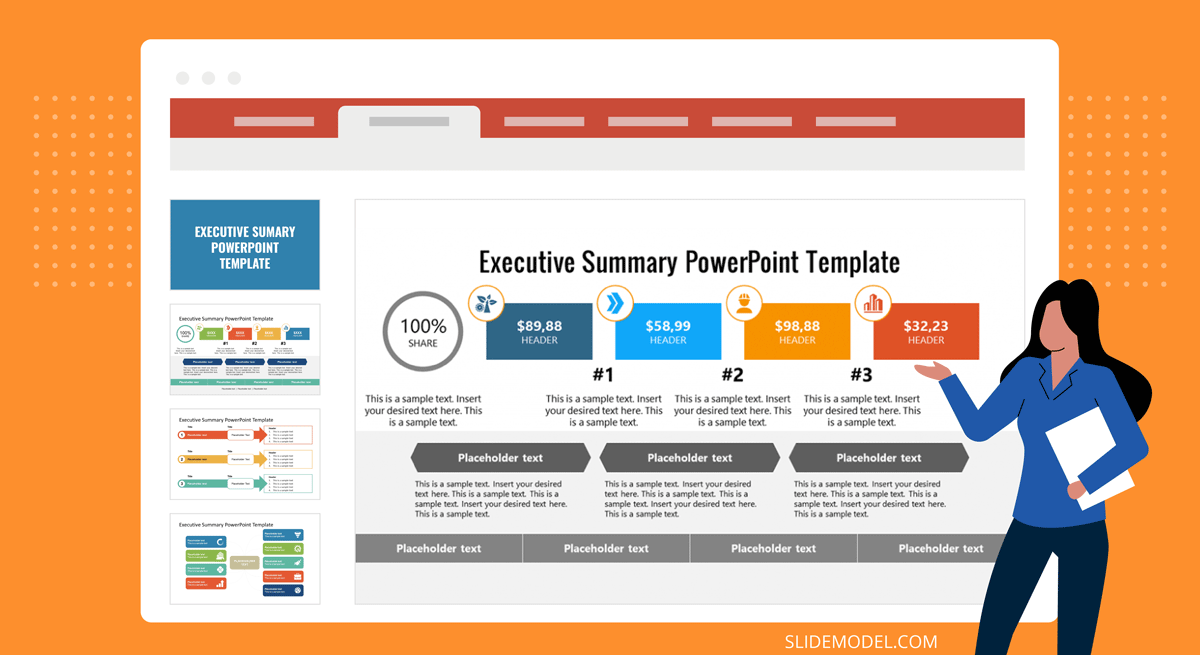
You can build an entire slide deck tailored for an executive summary or business presentation by using our AI Presentation Maker . Fill the topic, analyze & edit the proposed outline, and select a design. That’s it! You can create an engaging executive summary slide deck with any number of slides.
What Makes a Good Executive Summary Slide?
A good executive summary slide visually communicates all the important information from the full report. Typically, it’s an even more condensed version of the written executive summary, prefacing the document. Thus to create a good executive summary slide, be prepared to do some ruthless editing.
Include a condensed version of the:
- Main problem statement or report agenda
- Key findings. Prioritize quantifiable ones
- Recommendations and next steps.
Also, you will need some PowerPoint design mastery to ensure that an executive summary in your PowerPoint presentation looks compelling, but not cluttered. Prioritize white space. Here is where a good executive summary template can make your life easier. To minimize the number of texts, add icons and other simple visualizations. Trim headers and subheads to give the slide even more breathing room.
For those looking to create an engaging and visually appealing presentation, consider utilizing professional presentation templates to enhance the visuals of your executive summary slide. These templates are specifically designed to help presenters convey their message effectively and with style, ensuring that your audience remains captivated and fully understands the key points of your report.
How to Write an Executive Summary for a Presentation
Most likely you won’t need to write a brand new copy for this slide, but rather adapt the text at hand. That already makes your job a lot easier when summarizing a presentation into an executive summary slide. Still, you don’t want to mess anything up. So stick with the executive summary template you’ve chosen and fill in the gaps using our tips.
1. Keep the Tone Consistent
Use the same tone of voice and word choices in your slide deck as you’ve adopted in the report. If the tone of your presentation speech differs too much with terms used on the slide and in the report copy, some audience members may get confused, and then disengaged.
2. Focus on Telling a Story
Stakeholders will have the extra time to read the “dry” report. During the presentation, your main goal is to draw their attention to the most important issue, showcase the value-packed inside the report, and make them eager to learn more by actually flipping the full copy afterward.
3. Chop Full Sentences into Bullet Points
Go snappy and present information in a snackable manner. Remember, our brain can only keep 3-5 items at once in the working memory. So you shouldn’t try to overload the audience with a long list of “very important points” in one sitting.
Also, per a recent presentation survey, among the 3 things that annoy audiences most about presentations are slides that include full sentences of text. So, when working on your presentation summary slide, trim those lengthy texts and move on some of the other points to separate slides.
4. Don’t Go Data Galore
Including numbers and data visualizations is a great way to present your executive summary. However, overloading your data slides with data nuggets makes your presentation less impactful.
As presentation design expert Nancy Duarte explains :
“Data slides aren’t really about the data. They’re about the meaning of the data. It’s up to you to make that meaning clear before you click away. Otherwise, the audience won’t process — let alone buy — your argument.”
It’s a good idea to spotlight 3 main data points on your executive summary slide. Then use some extra minutes to comment on why you’ve chosen to present these.
To Conclude
An executive summary is the first page and/or slide a reader will see. That’s why the stakes are high to make it look just right. Granted, that shouldn’t be an issue. Since you now know how to write, design, and present a compelling executive summary to others!
1. Project Summary PowerPoint Template
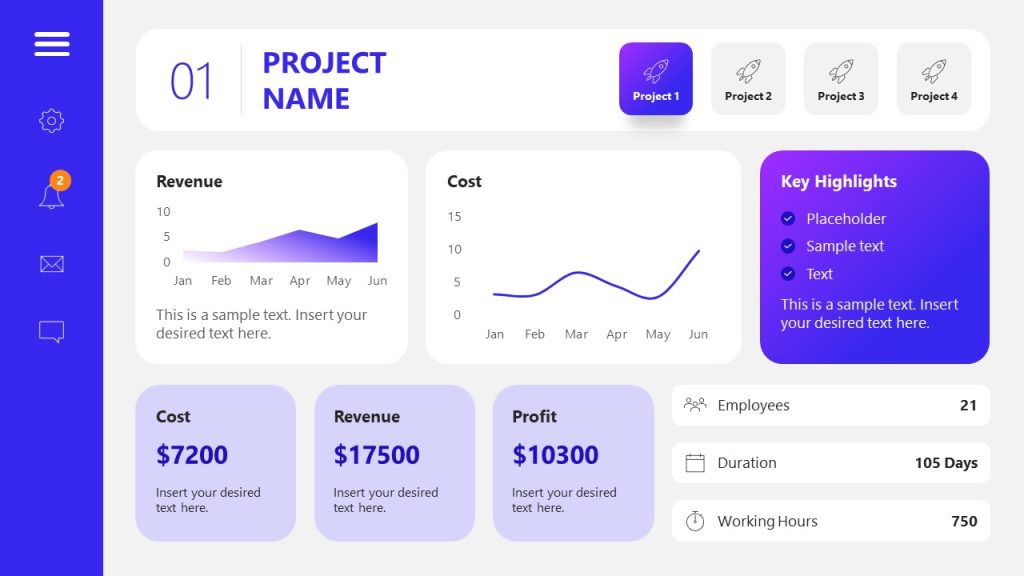
Use This Template
2. Simple Executive Summary Slide Template for PowerPoint
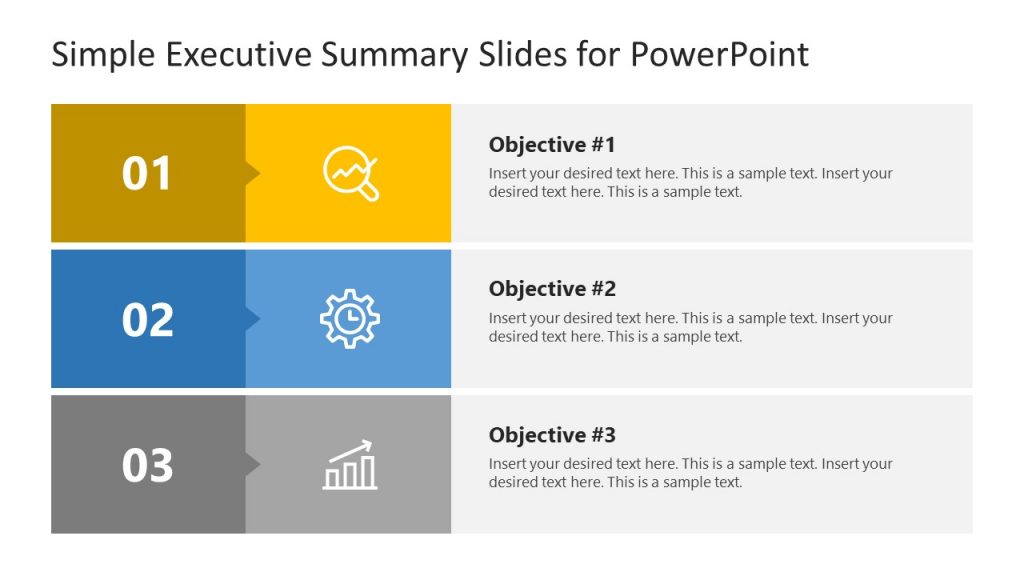
3. One Page Strategy Summary PowerPoint Template
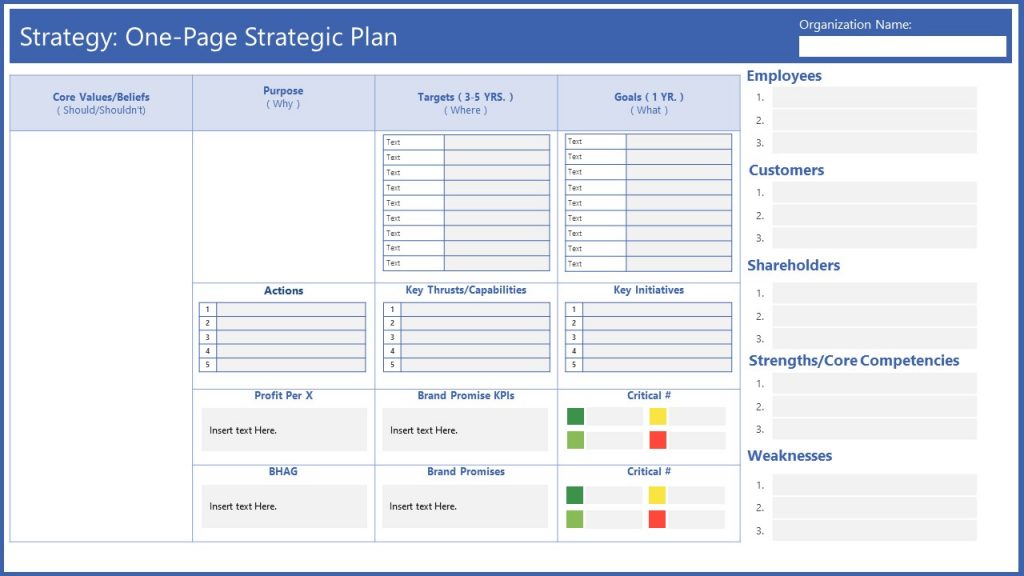
4. Executive Summary PowerPoint Template
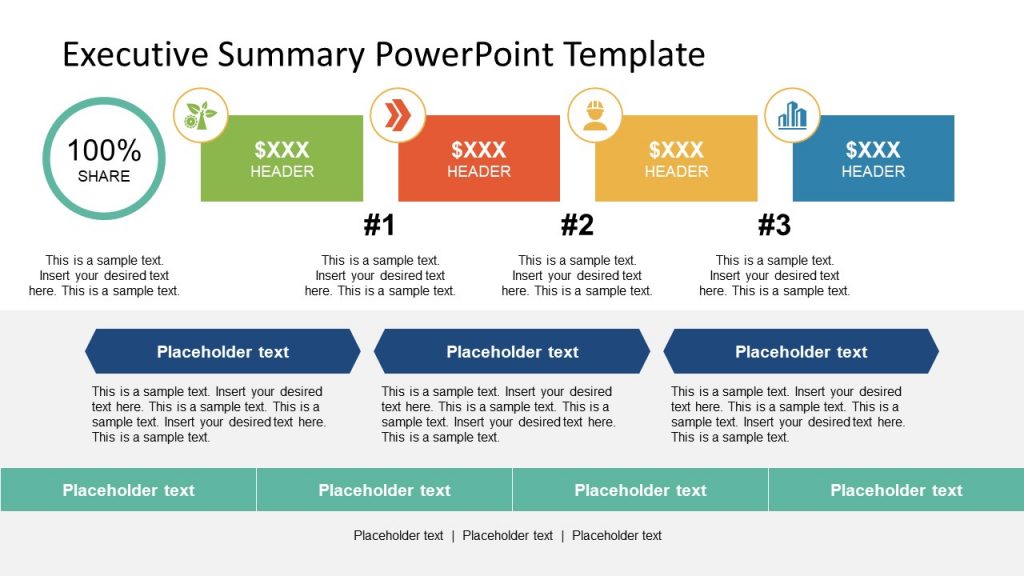
5. Executive Business PowerPoint Template

Like this article? Please share
Executive Reports, Executive Summary Filed under Business
Related Articles

Filed under Business • May 31st, 2024
How to Create an Appealing Report Presentation (Guide + Templates)
Discover the elements that make any kind of report presentation stand out. Recommendations for slide deck content and PPT templates.
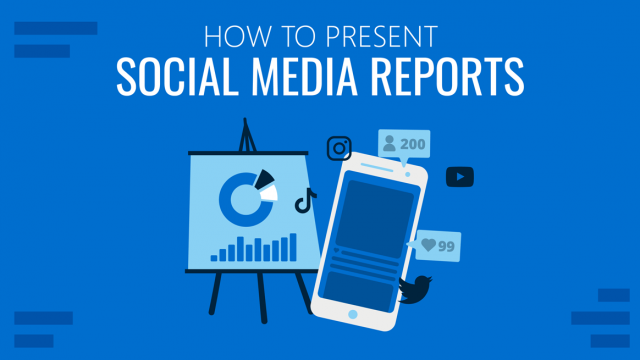
Filed under Business • February 29th, 2024
How to Create and Present Social Media Reports
This article helps small business community managers and account executives create effective social media reports to present to clients and their bosses.

Filed under Business • February 25th, 2024
Business Presentation: The Ultimate Guide to Making Powerful Presentations (+ Examples)
A business presentation is a purpose-led summary of key information about your company’s plans, products, or practices, designed for either internal or external audiences. This guide teaches you how to design and deliver excellent business presentations. Plus, breaks down some best practices from business presentation examples by popular companies.
Leave a Reply
- Strategy Templates
Consulting Templates
- Market Analysis Templates

- Business Case

- Consulting Proposal

- Due Diligence Report
All Templates
How to write an effective executive summary like a mckinsey or bcg consultant.

Table of contents
Key components of an effective executive summary, an in-depth look at each component of the executive summary (with examples), some practical tips and tricks, the bottom line.
Management consultants at firms like McKinsey, BCG, and Bain are renowned for their ability to present complex ideas in a clear, concise manner that is easy to digest and understand. A key component of this process is the executive summary slide – often presented as the first part of a presentation deck on a given topic or problem.
An executive summary aims to provide the audience with an overview of the subject at hand or a snapshot of the key points that will be discussed in greater depth. It should serve to quickly get the main messages and conclusions across and motivate audiences to dive deeper into the details.
In this post, we will outline the essential components of an effective executive summary using techniques from McKinsey, BCG, and Bain. We will also provide tips on how to craft a compelling executive summary in practice and give examples of best practices.
For a broader view on how to create consultant-style presentations take a look at our blog post 'How McKinsey Consultants Make PowerPoint Presentations' . Or deep-dive into other specific elements of creating best-in-class presentations, like our post on 'Mastering Risk Mitigation Slides: A Best Practice Guide with Examples'.
A good executive summary provides all the key information in one slide. The goal is to communicate as much information in as few words as possible.
To achieve this goal, you should focus on the following key components when crafting an executive summary slide:
- [optional] Objective: Clearly state the purpose and objective of the presentation.
- Situation: Provide relevant background information to set the context for the problem or opportunity being addressed.
- Complication: Define the complication (problem or opportunity) the presentation addresses in simple, to-the-point sentences. This includes identifying the root cause of the problem or opportunity and its implications for the organization.
- Resolution: Present the recommended solution or solutions to the complication in a clear and concise manner. This should be based on data-driven insights and analysis.
- [optional] Benefits: Articulate the benefits of implementing the recommended solution. These benefits should be linked to the organization's strategic objectives.
- Call to Action: Provide a clear call to action outlining what the organization needs to do to implement the recommended solution. This should be actionable and linked to the organization's strategic objectives.
This structure is similar to the SCQA (situation-complication-question-answer) framework.
Craft effective executive summaries for your consulting presentations .
Let's take a closer look at each component of the executive summary and how it can be used to craft an effective executive summary deck using the McKinsey/BCG/Bain methodology.
1. Objective
The objective of the executive summary should succinctly define the purpose of the presentation and why it is important for the audience to understand the key points.
To craft an effective objective, you should consider the following:
- Who is the target audience?
- What are the key points that the audience needs to understand?
- What is the purpose of the presentation?
- Why is it important for the audience to understand the key points?
An effective objective should be brief, clear, and focused on the needs of the audience. It should be written to clearly communicate what the presentation will cover and why it matters.
Example: "This presentation will provide an overview of the current state of the industry and highlight key trends and opportunities for growth."
2. Situation
The background or situation section of the executive summary provides relevant context to the audience to help them better understand the problem or opportunity being addressed.
This section should include:
- Relevant background information on the industry, market, or organization.
- Any key trends or developments that are important to the problem or opportunity being addressed.
- Any relevant historical information that helps to explain the current situation.
Some questions to ask when crafting the background section include:
- What is the context for the problem or opportunity being addressed?
- What are the key factors that have led to the current situation?
- What are the relevant historical or industry-specific factors that are important to understanding the problem or opportunity?
An effective background section should be concise and focused on the most important information. It should provide enough context for the audience to understand the problem or situation being addressed without overwhelming them with unnecessary information.
Here are some examples from McKinsey and BCG:
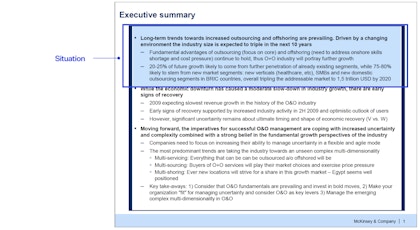
3. Complication
The complication section of the executive summary clearly and concisely defines the reason the situation requires action, either because there is a serious problem or there is a good opportunity. This includes identifying the root cause of the problem or opportunity and its implications for the organization.
- What is the problem or opportunity that the presentation is addressing?
- What are the root causes of the problem or opportunity?
- What are the implications of the problem or opportunity for the organization?
An effective complication section should be short and to-the-point, focusing on the most important aspects of the problem or opportunity. The root cause of the complication should be clearly identified, along with the most relevant data or evidence that supports this analysis. In addition, the implications of the problem or opportunity for the organization should be clearly articulated, highlighting why it is important for the audience to understand the problem/opportunity and its impact and why it requires action.
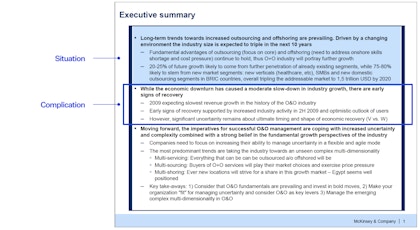
Enhance your proposal writing with our Consulting Proposal template , or explore our collection of 10 Real Consulting Proposals .
4. Resolution
The resolution section of the executive summary presents the proposed solution or strategy for addressing the complication. This should include a brief overview of the approach and any relevant supporting information or evidence.
- What is the proposed approach for addressing the problem or opportunity?
- What are the key elements of the strategy?
- What are the expected benefits or outcomes of the approach?
- What evidence is there to support the proposed solution or strategy?
An effective resolution section should provide enough detail for the audience to understand what is being proposed and why without overwhelming them with unnecessary detail. The proposed approach and any relevant supporting information or evidence should be clearly outlined. In addition, the expected benefits or outcomes of the approach should be highlighted, as this helps to emphasize why it is important for the audience to understand and support the proposed solution.
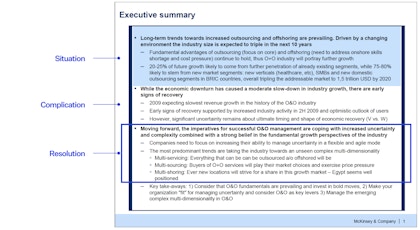
5. Benefits
The benefits section of the executive summary presents a brief overview of any expected benefits or outcomes from implementing the proposed solution. This section is optional, and sometimes included as a bullet point under the resolution section.
- What are the primary benefits or outcomes of implementing the proposed solution?
- What are the secondary benefits or outcomes?
- How will these benefits impact the organization and its stakeholders?
An effective benefits section should provide a clear and concise overview of any expected benefits or outcomes from implementing the proposed solution. The primary benefits should be highlighted, as well as any secondary benefits that are relevant to the audience. Emphasis should be on quantifiable benefits.
In addition, the impact of these benefits on the organization and its stakeholders should be emphasized, highlighting why it is important for the audience to understand and support the proposed solution.
Example: "The proposed approach will generate an incremental $10 million in revenue, reduce costs by 5%, and increase customer satisfaction by 10%. This will help to improve profitability, create new growth opportunities, and strengthen our competitive position in the sector."
6. Call to Action
The call to action section of the executive summary presents a brief overview of key proposed actions or decisions that need to be taken by the audience in order to implement the proposed solution. This section is also sometimes a bullet point under the resolution section.
- What are the proposed actions or decisions that need to be taken?
- Who needs to take these actions or make these decisions?
- What is the timeline for implementing the proposed solution?
An effective call to action/recommendation section should provide a clear and concise overview of any proposed actions or decisions that need to be taken by the audience. The proposed actions or decisions and who needs to take these actions or make these decisions should be clearly outlined.
In addition, the timeline for implementing the proposed solution should be highlighted, ensuring that the audience understands when and how these actions or decisions need to be taken.
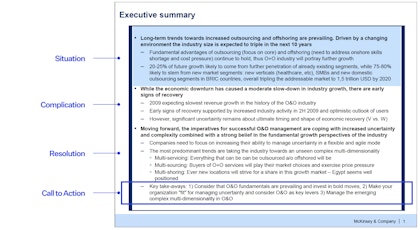
Apply these summary techniques in your Business Strategy template .
- Consultants typically communicate in a 'top down' or pyramid fashion, starting with the conclusion and then providing the supporting information.
- Write the most important takeaway of each section as the bolded text and follow with numbers and other supporting facts as bullet points.
- Read through the bolded text and see if the story makes sense.
- Spend the majority of the executive summary focusing on the solution/recommendation, rather than the situation and supporting analysis.
- The executive summary is not a play-by-play summary of a project. Instead, it is a decision document for your audience to understand the proposed solutions they have to decide on, and just enough information to set the solution in context and grasp the expected outcomes.
- Read through your executive summary and remove anything that is not directly relevant to deciding/agreeing with your proposed solution.
- Try to keep the executive summary as a single slide (sometimes two).
- Eliminate unnecessary words and sentences, and make sure that each sentence adds value to the overall message.
Creating executive summary slides like a McKinsey consultant can have a significant impact on the success of your communication and decision-making efforts. Although it seems simple and many people treat the executive summary like an after-thought, it should in fact be one of the slides you spend the most time on in any presentation.
A well-crafted executive summary helps you structure your entire presentation by making you focus on the solution you are proposing and only keeping in analyses and arguments that help explain the why, what, and how of that solution.
By following the essential components and strategies outlined above you can create a clear, concise, and compelling executive summary that effectively communicates complex ideas and drives action.
Cheat sheet
What is an executive summary exactly?
A short summary of the key messages and conclusions in a longer presentation, focused on actionable solutions or recommendations. In McKinsey and BCG consulting presentations the executive summary is typically one or two slides, but sometimes executive summary can also refer to a short deck.
What does an executive summary include and how do I write one?
See our 'How to' guide in this post.
Does an executive summary come before or after the table of contents?
Typically before the table of contents, as the first (or one of the first) slides after a title page.
Is there a good executive summary slide example?
Yes, you can download some examples from McKinsey and BCG here . You can also see full presentations from BCG and McKinsey here and here .
Or take a look at our full Business Strategy template or our Business Case template for real-life client examples.
Should I include visuals?
Generally McKinsey and BCG executive summaries do not include visuals, except perhaps icons to make the summary more visually appealing.
What is the difference between an executive summary slide and a key takeaways slide?
An executive summary slide, a recommendations slide , and a key takeaways slide are all part of a trio of slides centered around conveying main messages. Typically, an executive summary slide contains the most important points of the entire project/presentation while a key takeaways slide is often used either at the start or end of sections of the presentation to sum up points, or at the end to sum up the main takeaways before ending in an actionable recommendations slide.
Download our most popular templates
High-end PowerPoint templates and toolkits created by ex-McKinsey, BCG, and Bain consultants

Consulting toolkit and template
A comprehensive library of slide layouts, templates, and typically consulting tools and frameworks.

- Business Strategy
This template, created by ex-McKinsey and BCG consultants, includes everything you need to create a complete strategy.

Create a full business case incl. strategy, roadmap, financials and more.
Related articles
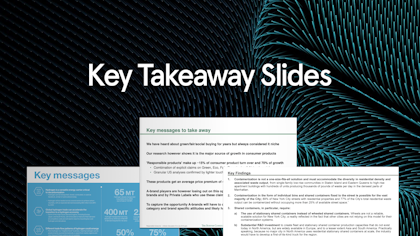
How to Write Key Takeaway Slides (with Examples and Free Template)
This guide, written by an ex-McKinsey consultant, teaches you how to create best-practice key takeaway slides based on a proven framework.
Sep 2, 2024
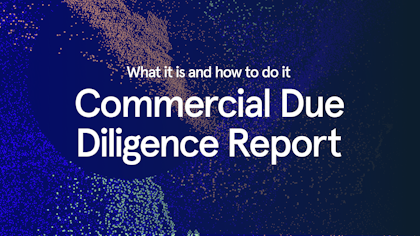
How to write a Due Diligence Report (with Examples and Template)
This guide, written by ex-BCG and Bain consultants, takes you through what a commercial due diligence report is, why it is important, and how to effectively craft your commercial due diligence slides.
Aug 19, 2024

Mastering Risk Mitigation Slides: A Best Practice Guide with Examples
Risk Mitigation Slides are an effective and efficient way to summarize your risk management strategy by assessing, prioritizing, and planning for risks. In this post, we will explore various risk mitigation slides and offer a few tips and tricks for building your own.
Jul 30, 2024

- Consulting Toolkit
- Market Analysis
- Market Entry Analysis
- Consulting Maps Bundle
- Mergers & Acquisitions
- Digital Transformation
- Product Strategy
- Go-To-Market Strategy
- Operational Excellence I
- Operational Excellence II
- Operational Excellence III
- Consulting PowerPoint Templates
- How it works
- Terms & Conditions
- Privacy Policy
© 2023 Slideworks. All rights reserved
Denmark : Farvergade 10 4. 1463 Copenhagen K
US : 101 Avenue of the Americas, 9th Floor 10013, New York
How it works
Transform your enterprise with the scalable mindsets, skills, & behavior change that drive performance.
Explore how BetterUp connects to your core business systems.
We pair AI with the latest in human-centered coaching to drive powerful, lasting learning and behavior change.
Build leaders that accelerate team performance and engagement.
Unlock performance potential at scale with AI-powered curated growth journeys.
Build resilience, well-being and agility to drive performance across your entire enterprise.
Transform your business, starting with your sales leaders.
Unlock business impact from the top with executive coaching.
Foster a culture of inclusion and belonging.
Accelerate the performance and potential of your agencies and employees.
See how innovative organizations use BetterUp to build a thriving workforce.
Discover how BetterUp measurably impacts key business outcomes for organizations like yours.
Daring Leadership Institute: a groundbreaking partnership that amplifies Brené Brown's empirically based, courage-building curriculum with BetterUp’s human transformation platform.

- What is coaching?
Learn how 1:1 coaching works, who its for, and if it's right for you.
Accelerate your personal and professional growth with the expert guidance of a BetterUp Coach.
Types of Coaching
Navigate career transitions, accelerate your professional growth, and achieve your career goals with expert coaching.
Enhance your communication skills for better personal and professional relationships, with tailored coaching that focuses on your needs.
Find balance, resilience, and well-being in all areas of your life with holistic coaching designed to empower you.
Discover your perfect match : Take our 5-minute assessment and let us pair you with one of our top Coaches tailored just for you.
Find your coach
-1.png)
Research, expert insights, and resources to develop courageous leaders within your organization.
Best practices, research, and tools to fuel individual and business growth.
View on-demand BetterUp events and learn about upcoming live discussions.
The latest insights and ideas for building a high-performing workplace.
- BetterUp Briefing
The online magazine that helps you understand tomorrow's workforce trends, today.
Innovative research featured in peer-reviewed journals, press, and more.
Founded in 2022 to deepen the understanding of the intersection of well-being, purpose, and performance
We're on a mission to help everyone live with clarity, purpose, and passion.
Join us and create impactful change.
Read the buzz about BetterUp.
Meet the leadership that's passionate about empowering your workforce.

For Business
For Individuals
How to write an executive summary in 10 steps

Whether presenting a business plan, sharing project updates with stakeholders, or submitting a project proposal, an executive summary helps you grab attention and convey key insights.
Think of it as a condensed version of a document, report, or proposal that highlights the most important information clearly and concisely. It's like a "cheat sheet" that gives you a snapshot of the main points without reading the entire thing.
Throughout the article, we'll explore some examples of executive summaries to give you a better understanding of how they can be applied. Plus, we'll provide you with ready-to-use templates and best practices for writing compelling executive summaries.
What is an executive summary?
An executive summary is a concise overview of a longer document or report. It is typically written for busy executives or decision-makers who may not have the time to read the entire document but still need to grasp its key points and recommendations.
An effective executive summary should capture the essence of the document, highlighting the most important information in a brief and easily understandable way. It should provide a snapshot of the document's purpose, methodology, major findings, and key recommendations. The summary should be written in a way that allows the reader to quickly grasp the main ideas and make informed decisions based on the information presented.
Why do you need to write one?
For a business owner , an executive summary is one of the most important documents you will have. Like a business plan , they help you lay out the potential value of your business and your potential for success.
Unlike a business proposal, however, an executive summary is designed to be read in a brief amount of time. That makes them ideal for a variety of uses, like project proposals and research summaries. Sending your strategic plan to a prospective investor or stakeholder likely won’t get you far. But a brief report that clearly states your key findings and what’s in it for them might help you — and your proposal — stand out. It isn't all the details. It's what gets you the meeting to share more.
An executive summary is also a business document that can travel without you. It may be presented to other leaders and potential investors. If it’s written well, it will take on a life of its own. You may find that you get support and resources from places you never imagined.
What should be included in an executive summary?
Your executive summary should include brief descriptions of who your product, service, or proposal is for and your competitive advantage. Be sure to introduce your report concisely yet clearly . Note the most important points and its overall purpose––what do you hope to achieve with this report?
Also, include any necessary background information and statistics about the industry, high-level information about your business model, necessary financial information, or other insights you discuss in the report. Depending on your proposal, you may want to consider summarizing a market analysis of your target market.
Typically, an executive summary follows a structured format, including sections such as:
- Introduction: Provides a brief background and context for the document.
- Objective or purpose: Clearly states the goal of the document and what it aims to achieve.
- Methodology: Briefly describes the approach, data sources, and methods used to conduct the research or analysis.
- Findings: Summarizes the main findings, conclusions, or results derived from the document.
- Recommendations: Outlines the key recommendations or proposed actions based on the findings.
- Conclusion: Provides a concise wrap-up of the main points and emphasizes the significance of the document.

How do you write an executive summary?
When tackling an executive summary, it's all about following a structured approach to ensure you effectively communicate those crucial points, findings, and recommendations. Let’s walk through some steps and best practices to make it a breeze:
Step 1: Get to know the document
Take the time to dive into the full document or report that your executive summary will be based on. Read it thoroughly and identify the main objectives, key findings, conclusions, and recommendations.
Step 2: Know your audience
Think about who you're writing the executive summary for. Consider their knowledge level, interests, and priorities. This helps you tailor the summary to their needs and make it relevant and impactful.
Step 3: Outline the structure
Create an outline for your executive summary with sections like introduction, objective, methodology, findings, recommendations, and conclusion. This way, you'll have a logical flow that's easy to follow.
Step 4: Start strong
Kick off your executive summary with a captivating opening statement. Make it concise, engaging, and impactful to hook the reader and make them want to keep reading.

Step 5: Summarize objectives and methodology
Give a brief overview of the document's objectives and the methodology used to achieve them. This sets the context and helps the reader understand the approach taken.
Step 6: Highlight key findings
Summarize the main findings, conclusions, or results. Focus on the juiciest and most relevant points that support the document's purpose. Keep it clear and concise to get the message across effectively.
Step 7: Present key recommendations
Outline the important recommendations or proposed actions based on the findings. Clearly state what needs to be done, why it matters, and how it aligns with the document's objectives. Make those recommendations actionable and realistic.
Step 8: Keep it snappy
Remember, an executive summary should be short and sweet. Skip unnecessary details, jargon, or technical language . Use straightforward language that hits the mark.
Step 9: Review and polish
Once you've written the executive summary, give it a careful review for clarity, coherence, and accuracy. Make sure it captures the essence of the full document and represents its content faithfully. Take the extra step to edit out any fluff or repetition.
Step 10: Dress to impress
Consider formatting and presentation. Use headings, bullet points, and formatting styles to make it visually appealing and easy to skim. If it makes sense, include some graphs, charts, or visuals to highlight key points.
Tips for writing an effective executive summary
- Adapt your language and tone to suit your audience.
- Keep things concise and crystal clear—say no to jargon.
- Focus on the most important info that packs a punch.
- Give enough context without overwhelming your reader.
- Use strong and persuasive language to make your recommendations shine.
- Make sure your executive summary makes sense even if the full document isn't read.
- Proofread like a pro to catch any pesky grammar, spelling, or punctuation errors.
Executive summary template for business plans
Here's a general template for creating an executive summary specifically for business plans:
[Your Company Name]
[Business Plan Title]
Business overview
Provide a brief introduction to your company, including its name, location, industry, and mission statement . Describe your unique value proposition and what sets your business apart from competitors.
Market analysis
Summarize the key findings of your market research. Provide an overview of the target market, its size, growth potential, and relevant trends. Highlight your understanding of customer needs, preferences, and behaviors.
Product or service offering
Outline your core products or services, including their key features and benefits. Emphasize how your offerings address customer pain points and provide value. Highlight any unique selling points or competitive advantages.
Business model
Explain your business model and revenue generation strategy. Describe how you will generate revenue, the pricing structure, and any distribution channels or partnerships that contribute to your business's success.
Marketing and sales strategy
Summarize your marketing and sales approach. Highlight the key tactics and channels you will use to reach and attract customers. Discuss your promotional strategies, pricing strategies, and customer acquisition plans.
Management team
Introduce the key members of your management team and their relevant experience. Highlight their expertise and how it positions the team to execute the business plan successfully. Include any notable advisors or board members.
Financial projections
Summarize your financial projections, including revenue forecasts, expected expenses, and projected profitability. Highlight any key financial metrics or milestones. Briefly mention your funding needs, if applicable.
Funding requirements
If seeking funding, outline your funding requirements, including the amount needed, its purpose, and the potential sources of funding you are considering. Summarize the expected return on investment for potential investors.
Reiterate the vision and potential of your business. Summarize the key points of your business plan, emphasizing its viability, market potential, and the expertise of your team. Convey confidence in the success of your venture.
Note: Keep the executive summary concise and focused, typically within one to two pages. Use clear and compelling language, emphasizing the unique aspects of your business. Tailor the template to suit your specific business plan, adjusting sections and details accordingly.
Remember, the executive summary serves as an introduction to your business plan and should pique the reader's interest, conveying the value and potential of your business in a concise and persuasive manner.
Executive summary examples
Every executive summary will be unique to the organization's goals, vision, and brand identity. We put together two general examples of executive summaries to spark your creativity and offer some inspiration.
These are not intended to be used as-is but more to offer ideas for how you may want to put your own executive summary together. Be sure to personalize your own summary with specific statistics and relevant data points to make the most impact.
Example 1: executive summary for a communications business plan
Introduction:
We're thrilled to present our innovative [insert product] that aims to revolutionize the way people connect and engage. Our vision is to empower individuals and businesses with seamless communication solutions that break barriers and foster meaningful connections.
Market opportunity:
The communications industry is evolving rapidly, and we've identified a significant opportunity in the market. With the proliferation of remote work, the need for reliable and efficient communication tools has skyrocketed. Our extensive market research indicates a demand for solutions that prioritize user experience, security, and flexibility.
Product offering:
At [Company Name], we've developed a suite of cutting-edge communication tools designed to meet the diverse needs of our customers. Our flagship product is a unified communication platform that integrates voice, video, messaging, and collaboration features into a seamless user experience. We also offer customizable solutions for businesses of all sizes, catering to their unique communication requirements.
Unique value proposition:
What sets us apart from the competition? Our user-centric approach and commitment to innovation. We prioritize user experience by creating intuitive interfaces and seamless interactions. Our solutions are scalable, adaptable, and designed to keep up with evolving technological trends. By combining ease of use with advanced features, we deliver unparalleled value to our customers.
Target market:
Our primary focus is on small and medium-sized businesses (SMBs) that require efficient and cost-effective communication tools. We also cater to individuals, remote teams, and larger enterprises seeking reliable and secure communication solutions. Our target market encompasses industries such as technology, finance, healthcare, and professional services.
Business model:
To generate revenue, we employ a subscription-based business model. Customers can choose from different plans tailored to their specific needs, paying a monthly or annual fee. We also offer additional services such as customization, integration, and customer support, creating additional revenue streams and fostering long-term customer relationships.
Marketing and sales strategy:
Our marketing strategy centers around building brand awareness through targeted digital campaigns, content marketing, and strategic partnerships. We'll leverage social media, industry influencers, and online communities to reach our target audience. Additionally, our sales team will engage in proactive outreach, nurturing leads and providing personalized consultations to convert prospects into loyal customers.
Team and expertise:
Our team is composed of experienced professionals with a deep understanding of the communications industry. Led by our visionary founder and supported by a skilled and diverse team, we have the expertise to drive innovation, develop robust products, and deliver exceptional customer service. We're passionate about our mission and dedicated to making a lasting impact in the market.
Financial projections:
Based on extensive market research and financial analysis, we anticipate strong growth and profitability. Our financial projections indicate steady revenue streams, with increasing customer adoption and market share. We're committed to managing costs effectively, optimizing our resources, and continuously reinvesting in research and development.
Funding requirements:
To fuel our ambitious growth plans and accelerate product development, we're seeking [funding amount] in funding. These funds will be allocated towards expanding our team, scaling our infrastructure, marketing efforts, and ongoing product innovation. We believe this investment will position us for success and solidify our market presence.
Conclusion:
In summary, [Company Name] is poised to disrupt the communications industry with our innovative solutions and customer-centric approach. We're ready to make a positive impact by empowering individuals and businesses to communicate effectively and effortlessly. Join us on this exciting journey as we redefine the future of communication. Together, we'll shape a connected world like never before.
Example 2: executive summary for a project proposal
[Project Name]
[Project Proposal Date]
Hello! We're thrilled to present our project proposal for [Project Name]. This executive summary will provide you with a high-level overview of the project, its objectives, and the value it brings.
Project overview:
Our project aims to [describe the project's purpose and scope]. It's a response to [identify the problem or opportunity] and has the potential to bring significant benefits to [stakeholders or target audience]. Through meticulous planning and execution, we're confident in our ability to achieve the desired outcomes.
Objectives:
The primary goal of our project is to [state the overarching objective]. In addition, we have specific objectives such as [list specific objectives]. By accomplishing these goals, we'll create a positive impact and drive meaningful change.
Our proposed approach for this project is based on a thorough analysis of the situation and best practices. We'll adopt a structured methodology that includes [describe the key project phases or activities]. This approach ensures efficient utilization of resources and maximizes project outcomes.
The benefits of this project are truly exciting. Through its implementation, we anticipate [describe the anticipated benefits or outcomes]. These benefits include [list specific benefits], which will have a lasting and positive effect on [stakeholders or target audience].
Implementation timeline:
We've devised a comprehensive timeline to guide the project from initiation to completion. The project is divided into distinct phases, with well-defined milestones and deliverables. Our timeline ensures that tasks are executed in a timely manner, allowing us to stay on track and deliver results.
Resource requirements:
To successfully execute this project, we've identified the key resources needed. This includes [list the resources required, such as human resources, technology, equipment, and funding]. We're confident in our ability to secure the necessary resources and allocate them effectively to ensure project success.
A project of this nature requires a well-planned budget. Based on our analysis, we've estimated the required funding to be [state the budget amount]. This budget encompasses all project-related costs and aligns with the anticipated benefits and outcomes.
Our project proposal is an exciting opportunity to address [the problem or opportunity] and create tangible value for [stakeholders or target audience]. With a clear vision, defined objectives, and a robust implementation plan, we're ready to embark on this journey. Join us as we bring this project to life and make a lasting impact.

Is an executive summary the same as a project plan?
While both are important components of project management and documentation , they serve different purposes and contain distinct information.
An executive summary, as discussed earlier, is a concise overview of a longer document or report. It provides a snapshot of the key points, findings, and recommendations. It focuses on high-level information and aims to provide an overview of the document's purpose, methodology, findings, and recommendations.
On the other hand, a project plan is a detailed document that outlines the specific activities, tasks, timelines, resources, and milestones associated with a project. It serves as a roadmap for project execution, providing a comprehensive understanding of how the project will be carried out.
A project plan typically includes objectives, scope, deliverables, schedule, budget, resource allocation, risk management, and communication strategies. It is intended for project team members, stakeholders, and those directly involved in the execution.
In summary, an executive summary offers a condensed overview of a document's key points, while a project plan provides a comprehensive and detailed roadmap for executing a project.
Executive summaries vs. abstracts
An executive summary is not the same as an abstract. Executive summaries focus on the main points of a proposal. They highlight when and why a reader should invest in the company or project.
An abstract, on the other hand, concentrates on what the business does and its marketing plan. It typically doesn’t include detailed information about finances.
While it is usually compelling, it’s less of an elevator pitch and more of a summary. The goal of an abstract is to inform, not to persuade. On the other hand, the goal of an executive summary is to give readers who are pressed for time just enough information that they’ll want to look further into your proposition.
When do you use an executive summary?
An executive summary is used in various situations where there is a need to present a condensed overview of a longer document or report. Here are some common instances when an executive summary is used:
- Business proposals: When submitting a business proposal to potential investors, partners, or stakeholders, an executive summary is often included. It provides a concise overview of the proposal, highlighting the key aspects such as the business idea, market analysis, competitive advantage, financial projections, and recommended actions.
- Reports and research studies: Lengthy reports or research studies often include an executive summary at the beginning. This allows decision-makers, executives, or other stakeholders to quickly understand the purpose, methodology, findings, and recommendations of the report without going through the entire document.
- Project updates: During the course of a project, project managers may prepare executive summaries to provide updates to stakeholders or higher-level management. These summaries give a brief overview of the project's progress, achievements, challenges, and upcoming milestones.
- Strategic plans: When developing strategic plans for an organization, an executive summary is often included to provide an overview of the plan's goals, objectives, strategies, and key initiatives. It allows executives and stakeholders to grasp the essence of the strategic plan and its implications without reading the entire document.
- Funding requests: When seeking funding for a project or venture, an executive summary is commonly used as part of the funding proposal. It provides a succinct summary of the project, highlighting its significance, potential impact, financial requirements, and expected outcomes.
In general, an executive summary is used whenever there is a need to communicate the main points, findings, and recommendations of a document concisely and efficiently to individuals who may not have the time or inclination to read the entire content. It serves as a valuable tool for understanding and facilitates quick decision-making.
5 ways project managers can use executive summaries
Project managers can use executive summaries in various ways to effectively communicate project updates, status reports, or proposals to stakeholders and higher-level management. Here are some ways project managers can use executive summaries:
- Project status updates: Project managers can provide regular executive summaries to stakeholders and management to communicate the current status of the project. The summary should include key achievements, milestones reached, challenges encountered, and any adjustments to the project plan. It allows stakeholders to quickly grasp the project's progress and make informed decisions or provide guidance as needed.
- Project proposals: When pitching a project idea or seeking approval for a new project, project managers can prepare an executive summary to present the essential aspects of the project. The summary should outline the project's objectives, scope, anticipated benefits, resource requirements, estimated timeline, and potential risks. It helps decision-makers understand the project's value and make an informed choice about its initiation.
- Project closure reports: At the end of a project, project managers can prepare an executive summary as part of the project closure report. The summary should highlight the project's overall success, key deliverables achieved, lessons learned, and recommendations for future projects. It provides a concise overview of the project's outcomes and acts as a valuable reference for future initiatives.
- Steering committee meetings: When project managers present updates or seek guidance from a steering committee or governance board, an executive summary can be an effective tool. The summary should cover the important aspects of the project, such as progress, issues, risks, and upcoming milestones. It ensures that decision-makers are well-informed about the project's status and can provide relevant guidance or support.
- Change requests: When submitting a change request for a project, project managers can include an executive summary to summarize the proposed change, its impact on the project, potential risks, and benefits. It helps stakeholders and decision-makers quickly assess the change request and make informed decisions about its implementation.
Using executive summaries, project managers can efficiently communicate project-related information to stakeholders, executives, and decision-makers. The summaries provide a concise overview of the project's status, proposals, or closure reports, allowing stakeholders to quickly understand the key points and take appropriate action.
When should you not use an executive summary?
While executive summaries are widely used in many situations, there are some cases where they may not be necessary or suitable. Here are a few scenarios where an executive summary may not be appropriate, along with alternative approaches:
- Highly technical documents: If the document contains highly technical or specialized information that requires a detailed understanding, an executive summary alone may not be sufficient. In such cases, it is better to provide the complete document and supplement it with explanatory materials, presentations , or meetings where experts can explain and discuss the technical details.
- Personal or creative writing: Executive summaries are typically used for informational or analytical documents. If the content is more personal in nature, such as a memoir, novel, or creative piece, an executive summary may not be relevant. Instead, focus on providing an engaging introduction or book blurb that entices readers and conveys the essence of the work.
- Short documents: If the document itself is already concise and can be easily read in its entirety, an executive summary may be redundant. In these cases, it is more effective to present the complete document without an additional summary.
- Interactive presentations: In situations where you can present information interactively, such as in meetings, workshops, or conferences, it may be more effective to engage the audience directly rather than relying solely on an executive summary. Use visual aids, demonstrations, discussions, and Q&A sessions to convey the necessary information and capture the audience's attention.
Final thoughts on writing a compelling executive summary
An executive summary isn’t the kitchen sink — it’s the bells and whistles. Geared toward busy decision-makers, these one-pagers communicate your case for action and proposed solutions. When it’s written well, your audience will walk away with an understanding of what needs to be done, why it needs to happen, and why they should help it move forward.
But writing it well doesn’t just mean spell-checking. It means tailoring your communication to an influential, yet busy and distracted audience. To be effective, you’ll need to write your proposal with empathy and an understanding of what matters to them .
Understand Yourself Better:
Big 5 Personality Test
Allaya Cooks-Campbell
With over 15 years of content experience, Allaya Cooks Campbell has written for outlets such as ScaryMommy, HRzone, and HuffPost. She holds a B.A. in Psychology and is a certified yoga instructor as well as a certified Integrative Wellness & Life Coach. Allaya is passionate about whole-person wellness, yoga, and mental health.
Tips for how to write a LinkedIn summary and examples
How to write a resume summary that works + examples, executive development is personalized to leaders everywhere, 12 resume career objective examples and tips for writing one, executive presence: what is it, why you need it and how to get it, how executive functioning governs daily life activities, what is a career statement, and should you write one, how to write a professional development plan for career success, what is executive coaching: benefits for the 2024 workforce, how to create a scope of work in 8 steps, 3 problem statement examples and steps to write your own, what’s a project scope, and how do you write one, how the minto pyramid principle can enhance your communication skills, how to make decisions like a multi-billion dollar corporation, cv versus resume demystify the differences once and for all, how to write a memo: 8 steps with examples, stay connected with betterup, get our newsletter, event invites, plus product insights and research..
3100 E 5th Street, Suite 350 Austin, TX 78702
- Platform Overview
- Integrations
- Powered by AI
- BetterUp Lead™
- BetterUp Manage™
- BetterUp Care®
- Sales Performance
- Diversity & Inclusion
- Case Studies
- Why BetterUp?
- About Coaching
- Find your Coach
- Career Coaching
- Communication Coaching
- Personal Coaching
- News and Press
- Leadership Team
- Become a BetterUp Coach
- BetterUp Labs
- Center for Purpose & Performance
- Leadership Training
- Business Coaching
- Contact Support
- Contact Sales
- Privacy Policy
- Acceptable Use Policy
- Trust & Security
- Cookie Preferences
- Product overview
- All features
- Latest feature release
- App integrations
CAPABILITIES
- project icon Project management
- Project views
- Custom fields
- Status updates
- goal icon Goals and reporting
- Reporting dashboards
- asana-intelligence icon Asana AI
- workflow icon Workflows and automation
- portfolio icon Resource management
- Capacity planning
- Time tracking
- my-task icon Admin and security
- Admin console
- Permissions
- list icon Personal
- premium icon Starter
- briefcase icon Advanced
- Goal management
- Organizational planning
- Project intake
- Resource planning
- Product launches
- View all uses arrow-right icon
Featured Reads

- Work management resources Discover best practices, watch webinars, get insights
- Customer stories See how the world's best organizations drive work innovation with Asana
- Help Center Get lots of tips, tricks, and advice to get the most from Asana
- Asana Academy Sign up for interactive courses and webinars to learn Asana
- Developers Learn more about building apps on the Asana platform
- Community programs Connect with and learn from Asana customers around the world
- Events Find out about upcoming events near you
- Partners Learn more about our partner programs
- Asana for nonprofits Get more information on our nonprofit discount program, and apply.
Project plans
- Team goals & objectives
- Team continuity
- Meeting agenda
- View all templates arrow-right icon
- Project planning |
- How to write an executive summary, with ...
How to write an executive summary, with examples

The best way to do that is with an executive summary. If you’ve never written an executive summary, this article has all you need to know to plan, write, and share them with your team.
What is an executive summary?
An executive summary is an overview of a document. The length and scope of your executive summary will differ depending on the document it’s summarizing, but in general an executive summary can be anywhere from one to two pages long. In the document, you’ll want to share all of the information your readers and important stakeholders need to know.
Imagine it this way: if your high-level stakeholders were to only read your executive summary, would they have all of the information they need to succeed? If so, your summary has done its job.
You’ll often find executive summaries of:
Business cases
Project proposals
Research documents
Environmental studies
Market surveys
In general, there are four parts to any executive summary:
Start with the problem or need the document is solving.
Outline the recommended solution.
Explain the solution’s value.
Wrap up with a conclusion about the importance of the work.
What is an executive summary in project management?
In project management, an executive summary is a way to bring clarity to cross-functional collaborators, team leadership, and project stakeholders . Think of it like a project’s “ elevator pitch ” for team members who don’t have the time or the need to dive into all of the project’s details.
The main difference between an executive summary in project management and a more traditional executive summary in a business plan is that the former should be created at the beginning of your project—whereas the latter should be created after you’ve written your business plan. For example, to write an executive summary of an environmental study, you would compile a report on the results and findings once your study was over. But for an executive summary in project management, you want to cover what the project is aiming to achieve and why those goals matter.
The same four parts apply to an executive summary in project management:
Start with the problem or need the project is solving. Why is this project happening? What insight, customer feedback, product plan, or other need caused it to come to life?
Outline the recommended solution, or the project’s objectives. How is the project going to solve the problem you established in the first part? What are the project goals and objectives?
Explain the solution’s value. Once you’ve finished your project, what will happen? How will this improve and solve the problem you established in the first part?
Wrap up with a conclusion about the importance of the work. This is another opportunity to reiterate why the problem is important, and why the project matters. It can also be helpful to reference your audience and how your solution will solve their problem. Finally, include any relevant next steps.
If you’ve never written an executive summary before, you might be curious about where it fits into other project management elements. Here’s how executive summaries stack up:
Executive summary vs. project plan
A project plan is a blueprint of the key elements your project will accomplish in order to hit your project goals and objectives. Project plans will include your goals, success metrics, stakeholders and roles, budget, milestones and deliverables, timeline and schedule, and communication plan .
An executive summary is a summary of the most important information in your project plan. Think of the absolutely crucial things your management team needs to know when they land in your project, before they even have a chance to look at the project plan—that’s your executive summary.
Executive summary vs. project overview
Project overviews and executive summaries often have similar elements—they both contain a summary of important project information. However, your project overview should be directly attached to your project. There should be a direct line of sight between your project and your project overview.
While you can include your executive summary in your project depending on what type of project management tool you use, it may also be a stand-alone document.
Executive summary vs. project objectives
Your executive summary should contain and expand upon your project objectives in the second part ( Outline the recommended solution, or the project’s objectives ). In addition to including your project objectives, your executive summary should also include why achieving your project objectives will add value, as well as provide details about how you’re going to get there.
The benefits of an executive summary
You may be asking: why should I write an executive summary for my project? Isn’t the project plan enough?
Well, like we mentioned earlier, not everyone has the time or need to dive into your project and see, from a glance, what the goals are and why they matter. Work management tools like Asana help you capture a lot of crucial information about a project, so you and your team have clarity on who’s doing what by when. Your executive summary is designed less for team members who are actively working on the project and more for stakeholders outside of the project who want quick insight and answers about why your project matters.
An effective executive summary gives stakeholders a big-picture view of the entire project and its important points—without requiring them to dive into all the details. Then, if they want more information, they can access the project plan or navigate through tasks in your work management tool.
How to write a great executive summary, with examples
Every executive summary has four parts. In order to write a great executive summary, follow this template. Then once you’ve written your executive summary, read it again to make sure it includes all of the key information your stakeholders need to know.
1. Start with the problem or need the project is solving
At the beginning of your executive summary, start by explaining why this document (and the project it represents) matter. Take some time to outline what the problem is, including any research or customer feedback you’ve gotten . Clarify how this problem is important and relevant to your customers, and why solving it matters.
For example, let’s imagine you work for a watch manufacturing company. Your project is to devise a simpler, cheaper watch that still appeals to luxury buyers while also targeting a new bracket of customers.
Example executive summary:
In recent customer feedback sessions, 52% of customers have expressed a need for a simpler and cheaper version of our product. In surveys of customers who have chosen competitor watches, price is mentioned 87% of the time. To best serve our existing customers, and to branch into new markets, we need to develop a series of watches that we can sell at an appropriate price point for this market.
2. Outline the recommended solution, or the project’s objectives
Now that you’ve outlined the problem, explain what your solution is. Unlike an abstract or outline, you should be prescriptive in your solution—that is to say, you should work to convince your readers that your solution is the right one. This is less of a brainstorming section and more of a place to support your recommended solution.
Because you’re creating your executive summary at the beginning of your project, it’s ok if you don’t have all of your deliverables and milestones mapped out. But this is your chance to describe, in broad strokes, what will happen during the project. If you need help formulating a high-level overview of your project’s main deliverables and timeline, consider creating a project roadmap before diving into your executive summary.
Continuing our example executive summary:
Our new watch series will begin at 20% cheaper than our current cheapest option, with the potential for 40%+ cheaper options depending on material and movement. In order to offer these prices, we will do the following:
Offer watches in new materials, including potentially silicone or wood
Use high-quality quartz movement instead of in-house automatic movement
Introduce customizable band options, with a focus on choice and flexibility over traditional luxury
Note that every watch will still be rigorously quality controlled in order to maintain the same world-class speed and precision of our current offerings.
3. Explain the solution’s value
At this point, you begin to get into more details about how your solution will impact and improve upon the problem you outlined in the beginning. What, if any, results do you expect? This is the section to include any relevant financial information, project risks, or potential benefits. You should also relate this project back to your company goals or OKRs . How does this work map to your company objectives?
With new offerings that are between 20% and 40% cheaper than our current cheapest option, we expect to be able to break into the casual watch market, while still supporting our luxury brand. That will help us hit FY22’s Objective 3: Expanding the brand. These new offerings have the potential to bring in upwards of three million dollars in profits annually, which will help us hit FY22’s Objective 1: 7 million dollars in annual profit.
Early customer feedback sessions indicate that cheaper options will not impact the value or prestige of the luxury brand, though this is a risk that should be factored in during design. In order to mitigate that risk, the product marketing team will begin working on their go-to-market strategy six months before the launch.
4. Wrap up with a conclusion about the importance of the work
Now that you’ve shared all of this important information with executive stakeholders, this final section is your chance to guide their understanding of the impact and importance of this work on the organization. What, if anything, should they take away from your executive summary?
To round out our example executive summary:
Cheaper and varied offerings not only allow us to break into a new market—it will also expand our brand in a positive way. With the attention from these new offerings, plus the anticipated demand for cheaper watches, we expect to increase market share by 2% annually. For more information, read our go-to-market strategy and customer feedback documentation .
Example of an executive summary
When you put it all together, this is what your executive summary might look like:
![what is an executive summary for a presentation [Product UI] Example executive summary in Asana (Project Overview)](https://assets.asana.biz/transform/8aa7d41f-aed9-4f82-bb7a-4305cea4404d/inline-project-planning-executive-summary-examples-1-2x?io=transform:fill,width:2560&format=webp)
Common mistakes people make when writing executive summaries
You’re not going to become an executive summary-writing pro overnight, and that’s ok. As you get started, use the four-part template provided in this article as a guide. Then, as you continue to hone your executive summary writing skills, here are a few common pitfalls to avoid:
Avoid using jargon
Your executive summary is a document that anyone, from project contributors to executive stakeholders, should be able to read and understand. Remember that you’re much closer to the daily work and individual tasks than your stakeholders will be, so read your executive summary once over to make sure there’s no unnecessary jargon. Where you can, explain the jargon, or skip it all together.
Remember: this isn’t a full report
Your executive summary is just that—a summary. If you find yourself getting into the details of specific tasks, due dates, and attachments, try taking a step back and asking yourself if that information really belongs in your executive summary. Some details are important—you want your summary to be actionable and engaging. But keep in mind that the wealth of information in your project will be captured in your work management tool , not your executive summary.
Make sure the summary can stand alone
You know this project inside and out, but your stakeholders won’t. Once you’ve written your executive summary, take a second look to make sure the summary can stand on its own. Is there any context your stakeholders need in order to understand the summary? If so, weave it into your executive summary, or consider linking out to it as additional information.
Always proofread
Your executive summary is a living document, and if you miss a typo you can always go back in and fix it. But it never hurts to proofread or send to a colleague for a fresh set of eyes.
In summary: an executive summary is a must-have
Executive summaries are a great way to get everyone up to date and on the same page about your project. If you have a lot of project stakeholders who need quick insight into what the project is solving and why it matters, an executive summary is the perfect way to give them the information they need.
For more tips about how to connect high-level strategy and plans to daily execution, read our article about strategic planning .
Related resources

How Asana drives impactful product launches in 3 steps
How to streamline compliance management software with Asana

New site openings: How to reduce costs and delays

Provider onboarding software: Simplify your hiring process
How To Write Consulting Executive Summary Slides [BCG Example]
Table of contents.
If you’re anything like me, then y ou build all of the main body slides in your slide decks, sharpen the text , perfect your visualizations … and then quickly throw together an executive summary slide.
The problem? The executive summary slide is the first impression of your deck and the only place that the reader can get a complete overview of your argument.
Therefore, executive summary slides shouldn’t be an afterthought. In fact, it’s important to spend significant time writing a strong executive summary that clearly articulates your argument and inspires your reader to act.
What is an executive summary slide?
An executive summary is a written overview of the main points or arguments of a larger document, memo or other report.
Strategy consultants also write executive summaries for their presentations or slide decks.
An executive summary slide is the first slide in your presentation that fully summarizes the argument, storyline, and supporting evidence of the body slides.

Download 120+ strategy consulting presentations for free
Looking for slide inspiration? Download 120+ consulting slide decks from top strategy consulting firms, such as McKinsey, BCG and Bain!
Why do you need executive summary slides?
As a reader, it’s so easy to get lost in a PowerPoint slide deck. You need to keep previous slides and messages in your mind, follow the line of argument, and somehow put everything together into a coherent story that you can make sense of.
Executive summary slides help the reader “follow along” with your slide deck. There are a few main benefits:
- Executive summaries provide context to help the reader understand why the topic of the slide deck is important.
- Executive summaries communicate the high-level argument before the reader gets into the body of the slide deck. This helps the reader understand your more detailed body slides.
- Executive summaries are a “map” that the reader can reference back to if they start losing the line of argument in the body of the deck.
How to write executive summary slides
To understand the best practices of writing executive summary slides, we’re going to break down a BCG executive summary.
In doing so, we’re going to learn the simple framework for writing executive summary slides that is used by strategy consultants, such as McKinsey & Co, Bain, and BCG.
Below you can see an example of a BCG executive summary. This slide deck is a BCG report on “Melbourne as a Global Cultural Destination” and can be downloaded here .
Here are the two main executive summary slides:
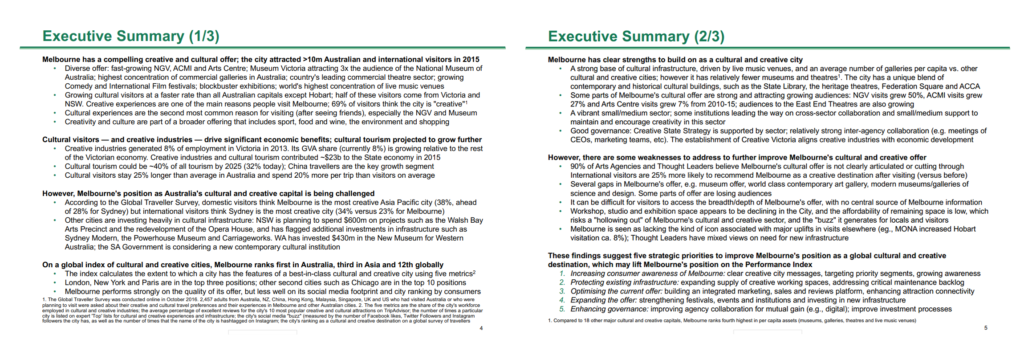
These BCG executive summary slides are a great example of an executive summary done well. So we’ll use them to describe best practices.
Best practice #1: Bold text for summary sentences, bullet points for supporting data
One of the first things you’ll notice about the BCG executive summary is the bold-bullet structure.
The bold sentences denote key statements or claims, and the bullet points support those statements (usually with data).
If there was no evidence to support their claims — or if the evidence was buried deep in the slide deck — then the reader could quite easily doubt the validity of the claim, and ultimately the end conclusion of the slide deck.
So one of the key aspects of strategy consulting slide decks is that no claim is made without evidence. And that includes the executive summary.
Let’s zoom in on one example:

The key statement in this part of the executive summary is “there are weaknesses in Melbourne’s cultural and creative offer”.
This claim is supported by a bunch of data points, such as 90% of agencies and thought leaders believe the cultural offer is not clearly articulated.
Best practice #2: Bold summary sentences can be read alone to tell a story
Executives are busy people and many of them aren’t interested in diving into the supporting bullet points. They will simply read through your bolded summary sentences to understand the high-level argument and recommendations.
This means that your executive summary should be “skimmable by design”.
In other words, your bolded summary sentences should tell a complete and logical story without requiring the supporting data in the bullet points below.
Let’s read just the bolded sentences in our BCG executive summary:
Melbourne has a compelling creative and cultural offer; the city attracted >10m Australian and international visitors in 2015. Cultural visitors and creative industries drive significant economic benefits; cultural tourism projected to grow further. However, Melbourne’s position as Australia’s cultural and creative capital is being challenged. On a global index of cultural and creative cities, Melbourne ranks first in Australia, third in Asia and 12th globally. Melbourne has clear strengths to build on as a cultural and creative city. However, there are some weaknesses to address to further improve Melbourne’s cultural and creative offer. These findings suggest five strategic priorities to improve Melbourne’s position as a global cultural and creative destination, which may lift Melbourne’s position on the Performance Index.
It reads just like a narrative!
Despite ignoring all the bullet points, we can still fully understand the argument that BCG is making in their executive summary (which is also reflected in the body of the slide deck).
Best practice #3: The executive summary should reflect the ‘SCR storyline’ structure of the slide deck
It’s not good enough to just “tell a story”, you need a tell the story using a particular structure.
The structure used by strategy consulting firms, such as McKinsey & Co, Bain, and BCG, is the ‘situation, complication, resolution’ structure.
As an aside, you can learn more about how to craft a compelling argument and SCR storyline for your slide deck in our Complete Guide To Building Strategy Presentations . If you haven’t read that guide, you should check it out.
Let’s take a look at how the SCR storyline applies to your slide deck:
- What baseline knowledge do people need to have before they understand our argument?
- How did this problem come about?
Complication
- What is the problem we need to solve?
- Why is this particular problem important to solve?
- How do we respond / solve the problem?
- What are the specific recommendations and/or next steps?
Your executive summary slide should communicate the complete storyline in your slide deck. And thus it should also follow the situation, complication, resolution structure.
In our BCG example, you can clearly see the SCR structure in action:
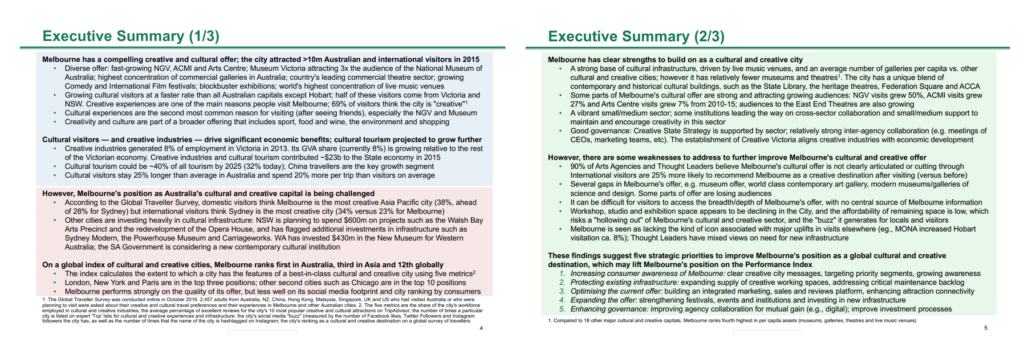
It’s important to set the context with the situation, as there’s no guarantee that all of you readers will have the background knowledge to understand your argument. It also gives you the opportunity to explain the causes of the problem that you’re addressing in the slide deck.
Then, in the complication section, you should succinctly define the problem and why it is important to solve. Some people suggest that you use a question format, for example “How can Melbourne improve its position as a global cultural and creative destination?”, although that’s really just a matter of style.
Finally, you need to clearly articulate your proposed resolution or “answer” to the problem. You’ll note that most of the executive summary real-estate is spent on the resolution component. From a reader’s perspective, the recommendations are the most important part of the slide deck.
Executive summary slide examples
Below you’ll find examples of executive summary slides from consulting firms like Bain & Co, BCG, L.E.K. Consulting, Oliver Wyman, and others.
![How To Write Consulting Executive Summary Slides [BCG Example] Bain executive summary slide](https://slidescience.co/wp-content/uploads/2021/09/Bain-executive-summary-slide.jpg)

IMAGES
VIDEO